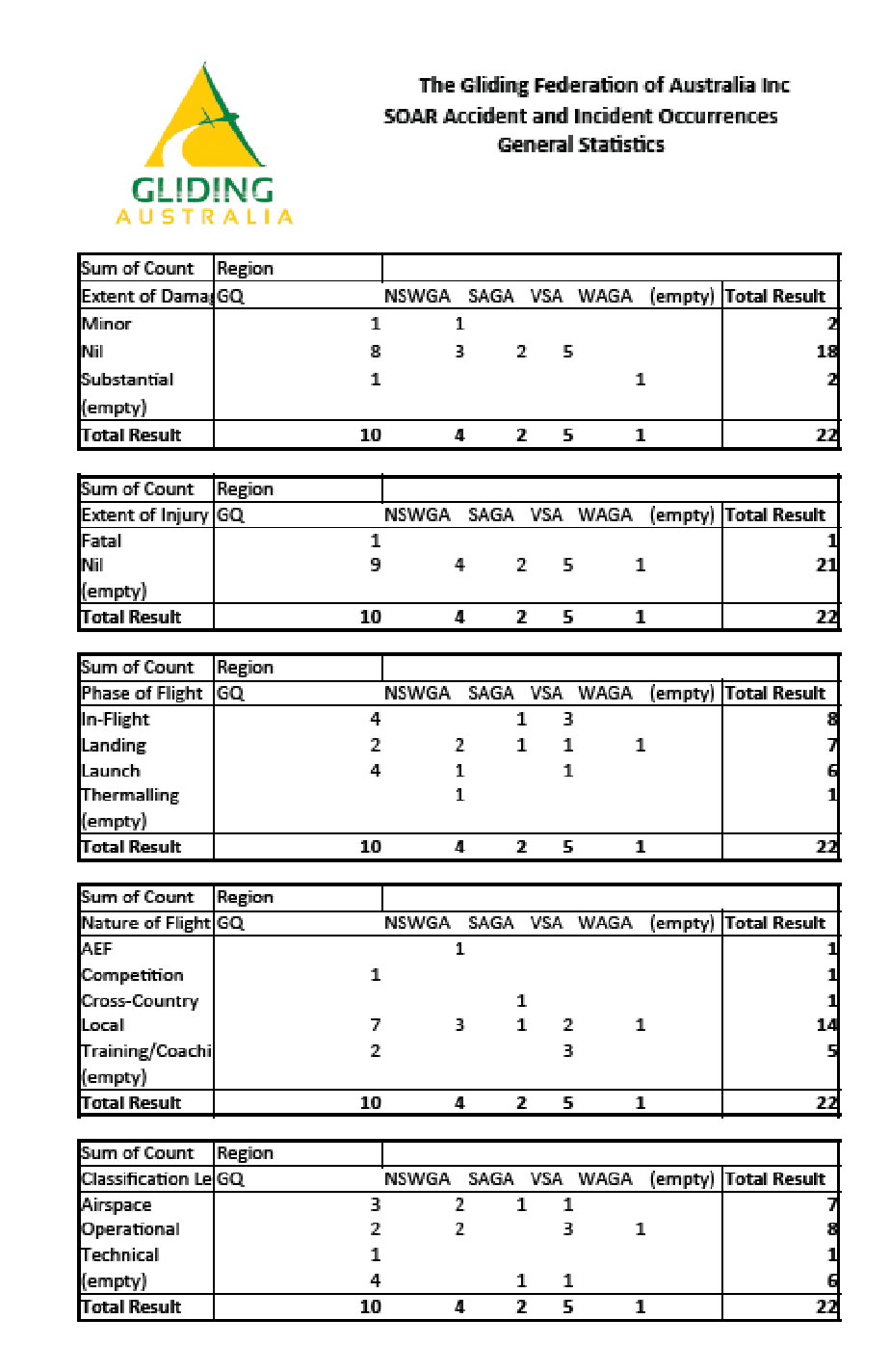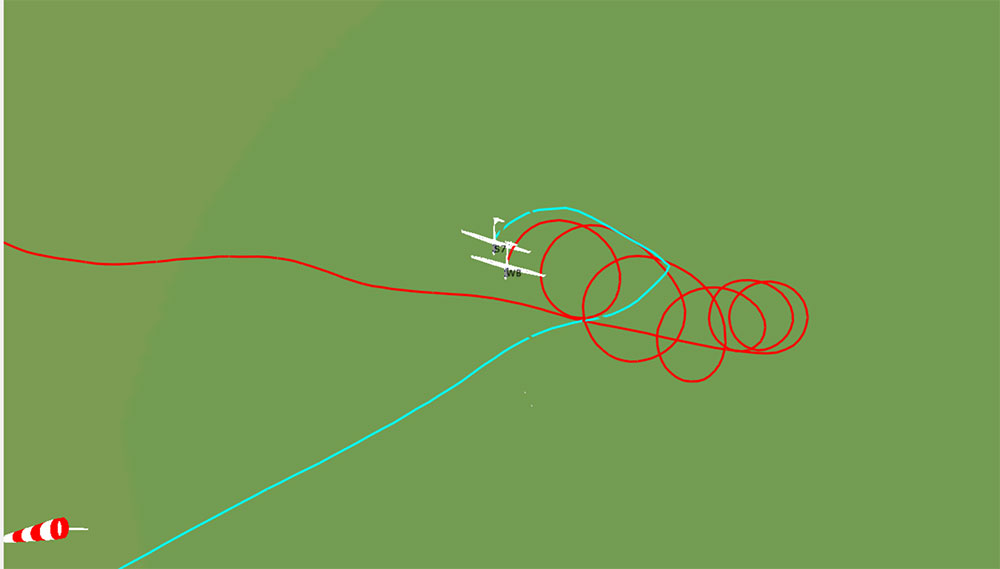All clubs and GFA members are urged to report all occurrences and incidents promptly, as and when they occur, using the GFA’s occurrence reporting portal at glidingaustralia.org/Log-In/log-in-soar.html. This is always best done while all details are fresh in everyone's mind.
You can read the full SOAR report at tinyurl.com/ltmko56
Reports noted 'Under investigation' are based on preliminary information received and may contain errors. Any errors in this summary will be corrected when the final report has been completed.

Date: 18/3/2023
Region: NSW
Aircraft Type: LS-8a and LS8-18
Classification Level 2: Aircraft Separation
Under investigation. During the second leg of a competition flight, the pilot of a glider established in a received a FLARM alert indicating an immediate threat. The pilot was unable to identify any reason for the FLARM warning and could not see any glider or any part of a glider while looking for signs of conflicting traffic. The FLARM alert was in response to another glider entering the thermal from directly behind and below and in the thermalling pilot’s blind spot. The entering glider then turned inside the other glider as its pilot opened the turn to sight the conflicting glider.

Date: 20/3/2023
Region: NSW
Aircraft Type: Mosquito and LS8
Classification Level 2: Aircraft Separation
Under investigation. Two gliders nearly collided while thermalling.
Date: 22/3/2023
Region: NSW
Aircraft Type: Discus B and LS8-18
Classification Level 2: Aircraft Separation
Under investigation. Two gliders nearly collided while thermalling.
Date: 18/3/2023
Region: NSW
Aircraft Type: Mosquito and LS4
Classification Level 2: Aircraft Separation
Under investigation. Two gliders nearly collided while thermalling. Approximately six gliders in the same thermal.
Date: 2/4/2023
Region: QLD
Aircraft Type: Standard Libelle 201 B
Classification Level 2: Wildlife
While thermalling near the Bunya Mountains a wedge tailed Eagle dived from above with legs extended and collided with the port wing of the glider. Inspection the left wing identified delamination of subsurface materials, chipped gelcoat and cracking in several areas extending over an area approximately 30cm diameter. Although birds and glider pilots often share the same thermal and can operate near each other with relative safety, birds can and do occasionally encounter a glider. While it is uncommon that a bird strike causes any harm to aircraft crew, many result in damage to aircraft. Wedge-tailed eagles are territorial and are known to defend around their nest sites from other wedge-tailed eagles and the occasional model airplane, hang glider, glider, fixed-wing aircraft or helicopter.
Date: 6/4/2023
Region: QLD
Aircraft Type: Jantar Standard 3
Classification Level 2: Terrain Collisions
Under investigation. On the return leg of a competition task conditions deteriorated, and the pilot conducted an outlanding into a cultivated paddock. During the flare, the pilot noticed a picket and wire fence across the landing run. The pilot conducted a ground loop to avoid contact with the fence.

Date: 6/4/2023
Region: QLD
Aircraft Type: Nimbus-2C
Classification Level 2: Miscellaneous
An inexperienced launch crew hooked the glider on for an aerotow launch but did not properly engage the rings in the release. At 150ft AGL the rings pulled free, and the glider was safely landed in a paddock. The glider was being launched from the CG release, as a nose release was not fitted, and the crew was unfamiliar with its operation.
Date: 6/5/2023
Region: QLD
Aircraft Type: LS8-18 and ASW20B
Under investigation. On the day of the accident, 10 gliders were competing in a local Grand Prix event and flying around a 150 km task. The task was a polygon with 5 turn points. The collision occurred in a thermal just after several gliders rounded the third turn point. The thermal was occupied by six gliders flying at similar heights. An LS 8-18 glider was the last to enter and, about halfway around its first turn, collided with an ASW 20B glider. Investigation is ongoing, but a review of the flight traces suggests the pilot of the LS 8-18 entered the thermal slightly below and possibly in a double-blind position with respect to the ASW 20B and stayed in this position until the moment of impact. If the pilots of both aircraft were in a position such that they could see the other, they did not, and this was possibly because they were looking at one or other glider in the thermal at the time. The pilot of the ASW 20B eventually noticed the other glider in close proximity, and the collision occurred when he took evasive action by rolling out of the turn. The gliders suffered no structural damage. The port aileron of glider the ASW 20B suffered a 150mm abrasion to the trailing edge, and the leading edge of the port wingtip of LS 8-18 suffered minor paint abrasion. Unfortunately, this is a known hazard in gliding competitions and Airprox events continue to occur despite pilots being trained in risk management for flying in proximity to other gliders. Since the introduction of Flarm, the incidence of actual collisions has dropped significantly. However, see-and-avoid remains the primary defence.
There is a theme in this month’s SOAR reporting. Flying near other gliders requires great care and concentration. Start gaggles, near airports, and turn points, are places where gliders congregate. Flying along cloud streets can create potential head on situations. As mentioned above, see-and-avoid is our primary defence. Clearing both left and right and above and below during entering of turns and exit of turns is very important.































